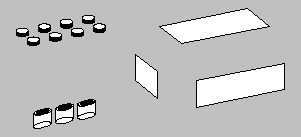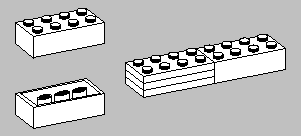LEGO® LANGUAGE
Note: This is NOT an official LEGO® Web site.
I just enjoy playing with LEGO® blocks.
LEGO® is a trademark of the LEGO Group
of companies which does not sponsor, authorize or endorse this site.
Return to Richard Taylor's Home Page.
Lego Robot Ant.
Lego Christmas Models.
Think about languages. Languages are ways in which we communicate with each other. We
want to express and share our ideas with other people. To do that, first we have to agree on
the pieces that make up our language. I could easily make up a new language and start saying
things like, "Drob smikt krong fa quing," but you wouldn't understand my idea because we
didn't agree first on what the words mean. So for a language to work, we need to begin with a
set of small, standard parts and an agreement on what they mean.
We also need some agreement or rules about how we are allowed to put those parts together. If
I said, "Dog cat over jumped.", you still wouldn't understand what I meant even though we
both might agree on the meaning of all the words. It would help if I followed the rules for
putting words together and said, "The dog jumped over the cat."
Putting smaller parts together to make larger parts is another interesting thing about languages.
They are made up of many layers, each layer being built of the simpler layer below. In written
languages, we put letters together to make words, we put words together to make sentences,
we put sentences together to make paragraphs, and we put paragraphs together to make stories.
In each layer, we have a set of parts, rules for putting the parts together, and we use particular
arrangements of parts to communicate ideas to other people.
BASIC IDEAS
- a set of small, standard parts,
- rules for putting together those parts,
- layers: a group of small parts can be considered as a part,
- groups of parts communicate ideas.
EXAMPLE 1: Written English
- The basic set of parts are the letters: a, b, c,...
We agree (usually) on what sounds each letter represents.
- There are rules for putting letters together into words:
- every word must have a vowel
- 'i' before 'e' except after 'c'...
- examples: cat, teacher, receive
- Layers:
- Words are a set of parts. We agree (in a dictionary) on what each word means.
- There are rules for putting words together into sentences:
- a sentence must have a noun and a verb (usually)
- example: 'The cat ate the mouse quickly.'
- More layers: sentences are parts of paragraphs...
- A single letter communicates the idea of a sound. A word communicates ideas like a
thing, an action or a characteristic. A sentence communicates ideas about how things
interact, or the relationships between things. A paragraph communicates... well, the
possibilities are endless.
But, written English is not the only language, and there are some ideas that are very difficult,
if not impossible, to communicate in English. Another example of a language that you are
probably familiar with is mathematics.
EXAMPLE 2: Mathematics
- The basic parts are numerals: 0, 1, 2, 3,...
We agree on the amounts that numerals represent.
- There are rules for putting numerals together:
- '0' should not be at the beginning
- position means power of 10
- examples: 253, 697, 1, 18
- Layers: - numbers combined with operators (+, -, x, =)
- numbers and operators are parts of expressions
- rules: number + number = number
example: 6 + 3 = 9
- You will learn more layers as you learn more mathematics.
- We use mathematics to express ideas about amounts and how amounts combine with
each other.
EXAMPLE 3: LEGO
Now let's think about Lego as a language. Have you ever tried to tell anyone in English how
to build a Lego model? I'll bet you soon said, "Here, let me show you..." Imagine trying to
write it down, or tell someone over the telephone. The ideas we want to communicate about
building things are not easy to express in English. But they are easy to express in Lego
Language.
|
1. The basic parts of Lego blocks are the knobs, holes, flat sides and right angled corners.
|
 |
2. There are rules for putting the basic parts together into blocks. For example:
- knobs on top, holes on bottom
- the spacing of knobs and holes is always the same
- the thickness or height of the bigger blocks is exactly three times the
thickness of the of the thinnest blocks
|
 |
3. Layers:
- The blocks we can buy are the parts. The Lego Group chooses the
"dictionary" of Lego blocks. These are the "words" of the Lego language. The
ideas they express are their shapes.
- There are rules for fitting blocks together; blocks only fit well in certain ways.
The rules also make sure that groups of blocks preserve the rules of the blocks.
You can easily imagine gluing a small group of blocks together to make a new
block. In fact, the Lego Group sometimes does this - if a particular structure
is very useful, they will produce it as a new Lego block.
- More layers: structures are parts of models or buildings, and you can put your
model houses, cars and trains together to build a whole village. A Lego village
would be like a story written in Lego Language.
- The ideas we communicate in Lego Language are ideas about shapes and
building structures and how various shapes can interact to do interesting things.
|
 |
Other Examples:
Can you think of some other examples of languages? What else uses sets of small parts that fit
together following some rules and has layers in which smaller parts make bigger parts and
bigger parts? How about the language of clothes? Threads are woven or knitted to make
material. Material is cut and stitched together to make shirts or dresses. Various clothes are
combined together to make an entire costume. What ideas do we communicate using the
language of clothes?
Continue with the vocabulary and grammar of Lego Language.
Return to Richard Taylor's Home Page.
Copyright © 1998 by
Richard P. Taylor


